Tumor stroma and chemokines control T-cell migration into melanoma following Temozolomide treatment
- PMID: 25949877
- PMCID: PMC4404877
- DOI: 10.4161/2162402X.2014.978709
Tumor stroma and chemokines control T-cell migration into melanoma following Temozolomide treatment
Abstract
The infiltration of T lymphocytes within tumors is associated with better outcomes in cancer patients, yet current understanding of factors that influence T-lymphocyte infiltration into tumors remains incomplete. In our study, Temozolomide (TMZ), a chemotherapeutic drug used to treat metastatic melanoma, induced T-cell infiltration into transplanted melanoma and into genitourinary (GU) tumors in mice developing spontaneous melanoma. In contrast, TMZ treatment did not increase T-cell infiltration into cutaneous tumors, despite similar increases in the expression of the (C-X-C) chemokines CXCL9 and CXCL10 in all sites after TMZ exposure. Our findings reveal that the matrix architecture of the GU tumor stroma, and its ability to present CXCL9 and CXCL10 after TMZ treatment played a key role in favouring T-cell infiltration. We subsequently demonstrate that modifications of these key elements by combined collagenase and TMZ treatment induced T-cell infiltration into skin tumors. T cells accumulating within GU tumors after TMZ treatment exhibited T helper type-1 effector and cytolytic functional phenotypes, which are important for control of tumor growth. Our findings highlight the importance of the interaction between tumor stroma and chemokines in influencing T-cell migration into tumors, thereby impacting immune control of tumor growth. This knowledge will aid the development of strategies to promote T-cell infiltration into cancerous lesions and has the potential to markedly improve treatment outcomes.
Keywords: CTL, cytolytic T lymphocyte; CXCL, Chemokine (C-X-C motif) ligand; ECM, extracellular matrix; GU, genitourinary; GZB, Granzyme B; HSPG, heparan sulphate proteoglycan; IFNγ, interferon γ; TAF, tumor-associated fibroblast; TILs, tumor-infiltrating lymphocytes; TMZ, Temozolomide; Th, T helper; Treg, T regulatory; WT, wild-type; chemokines; temozolomide; tumor stroma; tumor-infiltrating lymphocytes.
Figures
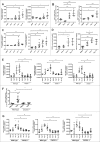

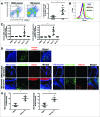

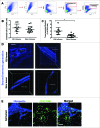
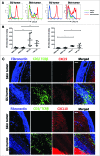
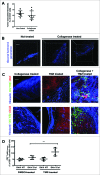
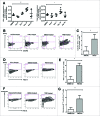
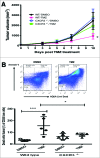
Similar articles
-
Intratumoral interferon-gamma increases chemokine production but fails to increase T cell infiltration of human melanoma metastases.Cancer Immunol Immunother. 2016 Oct;65(10):1189-99. doi: 10.1007/s00262-016-1881-y. Epub 2016 Aug 13. Cancer Immunol Immunother. 2016. PMID: 27522581 Free PMC article. Clinical Trial.
-
Strong expression of the lymphoattractant C-X-C chemokine Mig is associated with heavy infiltration of T cells in human malignant melanoma.J Pathol. 1999 Dec;189(4):552-8. doi: 10.1002/(SICI)1096-9896(199912)189:4<552::AID-PATH469>3.0.CO;2-I. J Pathol. 1999. PMID: 10629557
-
Chemotherapy induces intratumoral expression of chemokines in cutaneous melanoma, favoring T-cell infiltration and tumor control.Cancer Res. 2011 Nov 15;71(22):6997-7009. doi: 10.1158/0008-5472.CAN-11-1466. Epub 2011 Sep 26. Cancer Res. 2011. PMID: 21948969
-
Chemokine (C-X-C motif) ligand (CXCL)10 in autoimmune diseases.Autoimmun Rev. 2014 Mar;13(3):272-80. doi: 10.1016/j.autrev.2013.10.010. Epub 2013 Nov 2. Autoimmun Rev. 2014. PMID: 24189283 Review.
-
Immune modulations during chemoimmunotherapy & novel vaccine strategies--in metastatic melanoma and non small-cell lung cancer.Dan Med J. 2013 Dec;60(12):B4774. Dan Med J. 2013. PMID: 24355457 Review.
Cited by
-
Real-World Efficacy and Safety of Anti-PD-1 Antibody Plus Apatinib and Temozolomide for Advanced Acral Melanoma.Cancer Manag Res. 2025 May 1;17:905-916. doi: 10.2147/CMAR.S520937. eCollection 2025. Cancer Manag Res. 2025. PMID: 40331053 Free PMC article.
-
Peritumoral tertiary lymphoid structure and tumor stroma percentage predict the prognosis of patients with non-metastatic colorectal cancer.Front Immunol. 2022 Sep 16;13:962056. doi: 10.3389/fimmu.2022.962056. eCollection 2022. Front Immunol. 2022. PMID: 36189233 Free PMC article.
-
Trial watch: Immune checkpoint blockers for cancer therapy.Oncoimmunology. 2017 Aug 31;6(11):e1373237. doi: 10.1080/2162402X.2017.1373237. eCollection 2017. Oncoimmunology. 2017. PMID: 29147629 Free PMC article. Review.
-
T-cell Homing Therapy for Reducing Regulatory T Cells and Preserving Effector T-cell Function in Large Solid Tumors.Clin Cancer Res. 2018 Jun 15;24(12):2920-2934. doi: 10.1158/1078-0432.CCR-17-1365. Epub 2018 Feb 1. Clin Cancer Res. 2018. PMID: 29391351 Free PMC article.
-
The influence of stromal cells and tumor-microenvironment-derived cytokines and chemokines on CD3+CD8+ tumor infiltrating lymphocyte subpopulations.Oncoimmunology. 2017 May 8;6(6):e1323617. doi: 10.1080/2162402X.2017.1323617. eCollection 2017. Oncoimmunology. 2017. PMID: 28680763 Free PMC article.
References
-
- Pages F, Galon J, Dieu-Nosjean MC, Tartour E, Sautes-Fridman C, Fridman WH. Immune infiltration in human tumors: a prognostic factor that should not be ignored. Oncogene. 2010;29(8):1093-102. - PubMed
-
- Galon J, Costes A, Sanchez-Cabo F, Kirilovsky A, Mlecnik B, Lagorce-Pages C, et al. . Type, density, and location of immune cells within human colorectal tumors predict clinical outcome. Science. 2006;313(5795):1960-4. - PubMed
-
- Clemente CG, Mihm MC, Jr., Bufalino R, Zurrida S, Collini P, Cascinelli N. Prognostic value of tumor infiltrating lymphocytes in the vertical growth phase of primary cutaneous melanoma. Cancer. 1996;77(7):1303-10. - PubMed
LinkOut - more resources
Full Text Sources
Molecular Biology Databases
Research Materials
